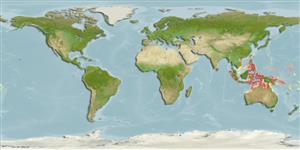Classification / Names
Common names | Synonyms | Catalog of Fishes (gen., sp.) | ITIS | CoL | WoRMS | Cloffa
Actinopterygii (ray-finned fishes) >
Perciformes (Perch-likes) >
Apogonidae (Cardinalfishes) > Apogoninae
Environment / Climate / Range
Ecology
Marine; benthopelagic; depth range 20 - 40 m (Ref. 90102). Tropical, preferred ?
Indo-West Pacific.
Size / Weight / Age
Maturity: Lm ? range ? - ? cm
Max length : 9.1 cm SL male/unsexed; (Ref. 11356)
Dorsal
spines
(total): 8;
Dorsal
soft rays
(total): 9;
Anal
spines: 2;
Anal
soft rays: 8. A brown band from tip of snout and chin to eye. A narrow black girdle encircles caudal peduncle at base of caudal, darkest at the point where it crosses the lateral line. A broad, dusky, black band across anterior dorsal spines; a subanal black band on second dorsal and anal, the black band confined to the membranes; rest of the fins hyaline (Ref. 11356).
On open substrate, schooling with large coral heads during the day. Usually trawled inshore on soft bottom (Ref. 48635).
Life cycle and mating behavior
Maturity | Reproduction | Spawning | Eggs | Fecundity | Larvae
Mouthbrooders (Ref. 240). Distinct pairing during courtship and spawning (Ref. 205).
Gloerfelt-Tarp, T. and P.J. Kailola, 1984. Trawled fishes of southern Indonesia and northwestern Australia. Australian Development Assistance Bureau, Australia, Directorate General of Fishes, Indonesia, and German Agency for Technical Cooperation, Federal Republic of Germany. 407 p. (Ref. 5978)
IUCN Red List Status (Ref. 115185)
CITES (Ref. 94142)
Not Evaluated
Threat to humans
Harmless
Human uses
More information
ReferencesAquacultureAquaculture profileStrainsGeneticsAllele frequenciesHeritabilityDiseasesProcessingMass conversion
Tools
Special reports
Download XML
Internet sources
Estimates of some properties based on models
Phylogenetic diversity index (Ref.
82805): PD
50 = 0.5000 [Uniqueness, from 0.5 = low to 2.0 = high].
Bayesian length-weight: a=0.01096 (0.00502 - 0.02394), b=3.11 (2.93 - 3.29), in cm Total Length, based on LWR estimates for this (Sub)family-body shape (Ref.
93245).
Trophic Level (Ref.
69278): 3.5 ±0.5 se; Based on size and trophs of closest relatives
Resilience (Ref.
69278): High, minimum population doubling time less than 15 months (Preliminary K or Fecundity.).
Vulnerability (Ref.
59153): Low vulnerability (12 of 100) .
